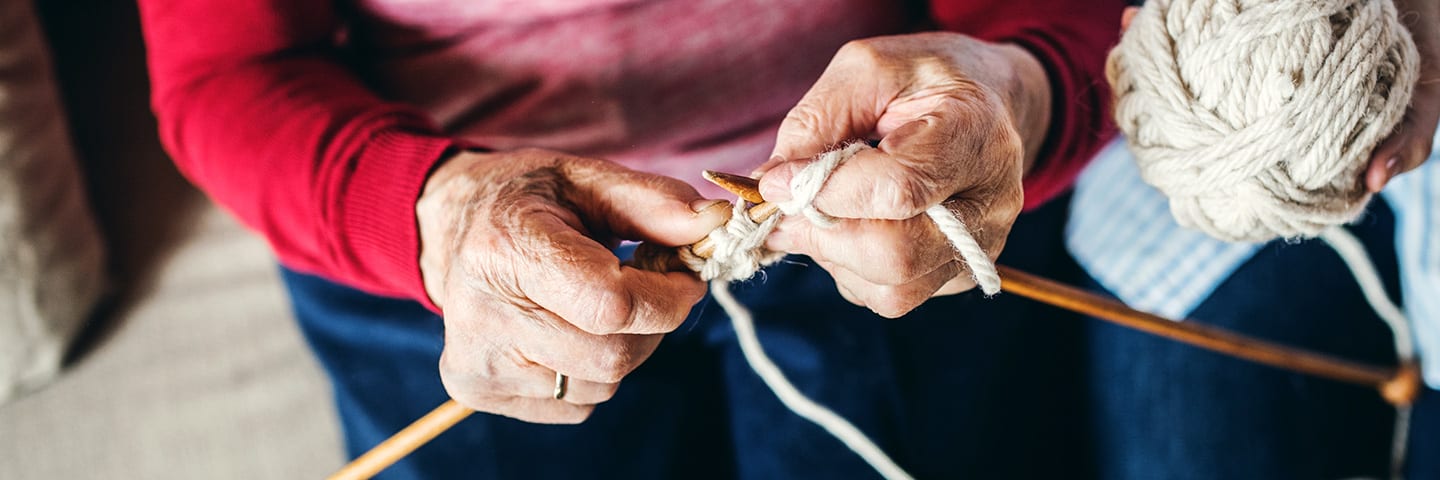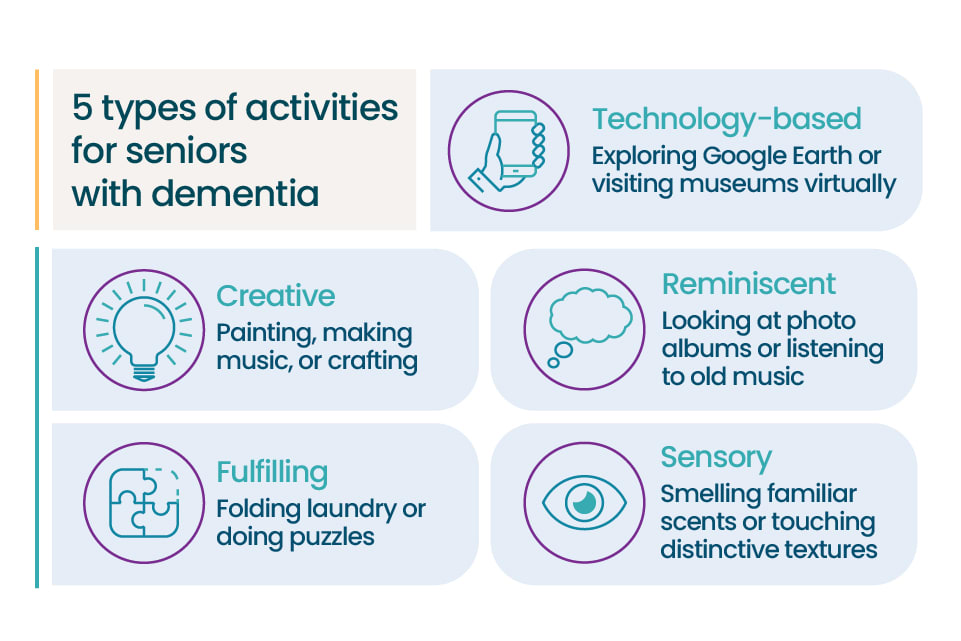
19 Engaging and Meaningful Activities for People With Dementia at Home

Creating a home environment that’s both comforting and stimulating can increase the joy in your loved one’s life if they live with dementia. When choosing activities, make sure you work within your loved one’s abilities to focus on joy and reduce frustration. Finding ways to be creative, reminisce, or bolster cognitive health through sensory experiences can be a great way to connect with your loved one. Each of these activities can be tailored for any senior with dementia.
Let our care assessment guide you
Our free tool provides options, advice, and next steps based on your unique situation.
Key Takeaways
- Creative activities keep seniors engaged and allow for emotional expression.
- Reminiscing activities provide cues to recall cherished memories.
- Seniors can enjoy feelings of accomplishment and self-worth through simple tasks like folding laundry and solving puzzles.
- Tailor activities to your loved one’s abilities to reduce frustration and anxiety.

Arts and crafts activities for seniors with dementia
One way to keep dementia patients engaged is to delve into their past interests or talents. Niki Gewirtz, a Senior Living Advisor at A Place for Mom and former executive director of a memory care community, recommends gaining a deep understanding of your loved one’s hobbies and strengths so that you can tailor activities to their interests and abilities.
Explore the following activities that can stir up a loved one’s former passions and strengths.
1. Paint or draw
Painting and drawing are ways to express feelings safely and with creativity. Encourage using bold, bright colors on big surfaces. Rolls of butcher paper enable seniors with dementia to create without encountering the stress of defined spaces. These activities for the elderly with dementia are not only fun but also can be therapeutic, as they promote emotional expression.
2. Do a craft
Activities involving different textures, such as playing with clay, offer tactile stimulation for dementia patients. Crafting with these materials or even exploring different shapes and sizes can be beneficial and enjoyable.
3. Create collages
Cut out images from magazines, or print old ads and articles. Choose subjects that fit your loved one’s interests, like cooking, cars, or fashion. Another idea is to scan and print old family pictures. Let your family member with dementia arrange and rearrange the elements to create pictures or scrapbook pages.
Reminiscence activities for dementia patients at home
Engaging in reminiscence therapy activities is a delightful way to help your loved ones recall cherished memories and exercise their cognitive abilities. These dementia activities utilize sensory and visual cues to gently guide seniors through their past, making them both meaningful and comforting.
4. Watch classic movies and TV shows
Keep dementia patients engaged by arranging nostalgic movie nights. Whether they were fans of westerns like Gunsmoke or adored musicals like The King and I, watching these old favorites can provide both entertainment and memory stimulation.
5. Listen to music and sing
“Music can awaken the brain, and with it, the rich trove of memories that are associated with familiar songs,” according to the nonprofit group Music and Memory. Stream classics or sing memorable songs like holiday carols. Sing-alongs and music classes were more common in mid-century schools; you might be surprised at how many songs your loved one remembers from childhood.
6. Look through photo albums
One of the most heartwarming activities for dementia seniors involves revisiting old photo albums. These albums, filled with images from their younger years, can help to reignite treasured memories. You could also digitize these pictures and create virtual memory books to make this more interactive.
7. Flip through magazines and catalogs
Before the era of modern shopping, catalogs and magazines played a significant role in staying informed about trends. Finding copies or reprints of magazines they once enjoyed, such as Life or Cosmopolitan, or even the Sears, Roebuck and Co. catalog, can be one of the most engaging things for dementia patients to do.
Read more: Music Therapy for Dementia

Let our care assessment guide you
Our free tool provides options, advice, and next steps based on your unique situation.
Fulfilling activities for people with dementia at home
Fulfilling activities can significantly contribute to a senior’s quality of life, fostering feelings of achievement and self-worth. These dementia activities should be tailored to the senior’s cognitive level, ensuring they feel engaged and productive without being overwhelmed.
8. Fold laundry
This routine task is one of the most calming activities for seniors with dementia. The familiar process of folding soft fabrics and the scent of classic detergents can evoke comforting memories. Start with uncomplicated items like hand towels and T-shirts for this simple yet fulfilling task.
9. Enjoy hands-on activities
For people who enjoyed do-it-yourself projects, suggest activities that yield visible results. Painting wooden boards or assembling PVC pipes are ideal things for dementia patients to do, particularly for seniors with good motor function. For people with more advanced dementia, wooden or plastic play tools can offer a similar sense of achievement.
10. Untie knots
This is one of the tactile activities for dementia patients that can keep them engaged. Tie loose knots along a durable, comfortable rope. The act of untying can provide both cognitive and physical stimulation without causing frustration or discomfort.
11. Do a puzzle
Puzzles for seniors with dementia, such as large-piece, color, or shape puzzles with tactile pieces, can be both entertaining and cognitively beneficial.
12. Play a game
Board games like Guess Who? and Battleship are ideal because they stimulate memory and cognitive skills in a fun and engaging way while being straightforward enough not to cause confusion or frustration. Guess Who? can help with facial recognition and memory, while Battleship encourages strategic thinking. Even more playful options like a remote-controlled pet can bring immense joy and engagement. These toys can stimulate a sense of caring and provide amusement as your loved one controls the pet’s movements.
Read more: 5 Best Puzzles for Dementia Patients
Sensory activities for seniors with dementia
The following dementia activities can stimulate the senses and evoke fond memories, leading to a more fulfilled and engaged life for your loved one.
13. Stop and smell the roses
Scents can trigger stronger emotional memories than visuals, as they’re processed in the brain’s memory control areas. Surrounding your loved one with familiar smells, like fresh-cut grass or the aroma of warm bread, could evoke joyful memories and emotions. It’s crucial to avoid smells that could cause distress, like diesel fuel or gunpowder, which can be triggers for older veterans.
14. Touch old, familiar objects
Engaging in tactile activities for dementia patients can stimulate reminiscence. Even if they can’t recall specific events, touching familiar objects, like keys or hand-embroidered beads, can trigger memories.
15. Taste favorite foods
Like smells, tastes can elicit emotions and memories. Your mom’s famous chocolate cake could bring back birthdays; a sip of instant coffee could recall quiet, early mornings at home.
16. Feel diverse textures
Experiencing different textures can be a fulfilling dementia activity that provides sensory stimulation and memory cues. Consider things that align with their interests: soft animal fur for pet lovers or damp soil and leaves for seniors who enjoyed gardening. Create an activity around this by making a bag of varied textures to be sorted by touch.
Technology-based dementia activities for seniors
Technology can offer stimulating, engaging, and mentally nourishing experiences for seniors with dementia. Here are some innovative ways technology can facilitate dementia activities and keep seniors living with dementia engaged at home.
17. Discover nature and art through live cams
A wealth of global attractions, from zoos and nature preserves to museums, offer live internet streams. Whether your loved one has a fondness for animals or an appreciation for art, they can experience ever-changing visual stimulation without leaving the comfort of home.
18. Venture globally with Google Earth
Google Earth offers a virtual exploration experience like no other through user-uploaded photos. Whether your loved one cherishes memories of their childhood hometown or dreams of the Sahara Desert, Google Earth can offer them a gateway to explore these places.
19. Create a family video tablet for dementia patients at home
Video calls and chats can keep families connected, and technology can offer comfort even when a conversation isn’t possible. Creating a collection of videos featuring family members, beloved pets, and memorable moments on a tablet can be an ideal activity for dementia patients at home. This personalized tablet can provide solace during restless times or assist with sleep. If a tablet is too complex, consider transferring these precious videos onto a classic videotape or DVD.
This guide has explored a variety of engaging activities that were designed to enhance cognitive health and emotional comfort for seniors — from revisiting past interests and delving into creative expressions, to reminiscing about cherished memories and fulfilling everyday tasks.

Talk with a Senior Living Advisor
Our advisors help 300,000 families each year find the right senior care for their loved ones.
Tips for planning activities for seniors with dementia
When choosing activities for seniors with dementia, it’s important to consider their current cognitive abilities, their interests, and the stage of their dementia. Activities should ideally be simple, enjoyable, and familiar to reduce frustration and anxiety.
Activities for mild (early-stage) dementia
In the early stages, individuals retain much of their independence and their cognitive abilities, though they may have trouble remembering recent events or managing complex tasks.
Good activities for this stage might include:
- Reading books
- Solving a crossword or other puzzles
- Gardening
- Cooking or baking
- Attending social events
Activities can also include learning new, simple skills, as this stage of dementia is often marked by a desire to continue personal growth and development.
Activities for moderate (middle-stage) dementia
As dementia progresses into the middle stage, individuals may begin to have difficulty recognizing familiar people and places, and they may struggle with tasks that require multiple steps.
Activities should be simplified and broken down into single steps during this stage. Simple tasks, creative arts, and craft activities like these may be suitable:
- Painting or making a scrapbook
- Singing old songs or listening to their favorite artists
- Going on short walks
- Doing simple chores
- Assisted cooking
Activities for severe (late-stage) dementia
In the late stages of dementia, individuals often have significant memory loss and may have difficulty communicating or recognizing loved ones. However, they can still benefit from sensory and emotional experiences.
Simple tactile activities like the following can be comforting and soothing for individuals with late-stage dementia:
- Handling a soft blanket
- Squishing clay
- Listening to familiar music
- Looking at family photos
- Receiving gentle massages with a favorite lotion
- Enjoying the outdoors in a safe and comfortable manner
Remember that everyone is unique, and the progression of dementia varies significantly among individuals. Always tailor activities to the person’s individual abilities and interests. The goal is not to challenge them with difficult tasks but to provide comfort, stimulate their senses, and create opportunities for meaningful engagement.
Dementia care activities in memory care
If it’s becoming difficult to care for your loved one with dementia at home, you may want to consider memory care.
However, if you’re not sure whether memory care communities will be able to fulfill and engage your loved one, here’s some internal data on how many communities within A Place for Mom’s network incorporate different types of activities:[01]
- Over 55% of memory care communities offer cooking activities, and about 70% offer art activities to engage residents in unique ways.
- Over 55% of communities offer reminiscence programs dedicated to helping seniors recall cherished memories.
- Over 52% of communities offer sensory-based programs to engage residents with dementia through sound, touch, scent, taste, and sight.
- Over 78% of communities offer musical activities like karaoke and live musical performances to soothe common dementia symptoms.
- Over 70% of communities offer an enclosed courtyard to help residents enjoy the outdoors in a safe manner.
If you’re not quite ready to move your loved one but still want help around the home, you can look into home care.
To help you learn more about care options, reach out to A Place for Mom’s Senior Living Advisors. They can offer advice and help you find local care options that meet your loved one’s unique needs and preferences, all at no cost to your family.
Families also ask
How do I make an activity blanket for dementia patients?
You can make an activity blanket to keep your parent stimulated by choosing fabric and attaching items of different textures, like buttons, zippers, or ribbons, to it.
Where can I buy activities for dementia patients?
You can buy activities for dementia patients online. Some vendors specialize in toys and games for senior with dementia. You can also make activities from items you have at home.
Do fidget blankets work for dementia patients?
Yes, fidget blankets keep dementia patients stimulated and give them something to do with their hands. It can ease symptoms of restlessness and anxiety.
Key Takeaways
[1] A Place for Mom. (2024). A Place for Mom proprietary data.
Senior living options in all states
The information contained on this page is for informational purposes only and is not intended to constitute medical, legal or financial advice or create a professional relationship between A Place for Mom and the reader. Always seek the advice of your health care provider, attorney or financial advisor with respect to any particular matter, and do not act or refrain from acting on the basis of anything you have read on this site. Links to third-party websites are only for the convenience of the reader; A Place for Mom does not endorse the contents of the third-party sites.
Make the best senior care decision
Make the best senior care decision